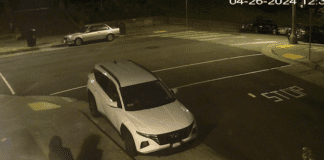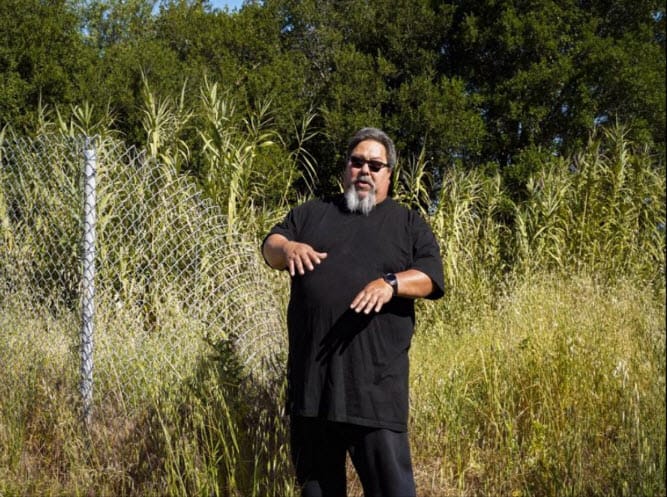
ALERT: Scroll down to watch a mini-documentary “The Superfund in San Francisco” or go to https://youtu.be/ZVzUmyj3RVI?si=kJPnjZi_MPjZbvGf.
by Ahimsa Porter Sumchai MD
John Joseph Miranda is a humble man – loyal to his family, friends and to his job. Miranda is a UCSF senior animal technician who, for 26 years, worked at Building 830 at 75 Crisp Rd, located on the southwestern border of the Hunters Point Naval Shipyard.
The Crisp Road campus 800 series buildings housed the main laboratories, administrative offices, storage areas and animal kennels used by scientists of the Naval Radiological Defense Laboratories from 1946 through 1969, when NRDL was officially disestablished.
By 1955 NRDL had attracted “the best and the brightest” from the surrounding universities Lawrence Livermore, UC Berkeley, UCSF and Stanford. NRDL laboratory, classroom and administrative operations were consolidated into Building 815, the six-story windowless structure that has become a shipyard landmark – second only in stature to the iconic Hunters Point Gantry Crane.
Deep soil excavations and heavy equipment operations are being actively conducted by Navy “slumlords” in front of 30 State of California workers “held hostage” in Building 830, at 75 Crisp Rd. on the Hunters Point Naval Shipyard Federal Superfund system.
The UCSF compound is 200 feet north of a methane emitting radiation contaminated industrial landfill designated Parcel E-2. In 2012 Parcel E-2 underwent a CERCLA action characterizing it to contain radionuclides and PCBs. This action legally amounts to a Federal Superfund designation and the Navy was fined $85,000.
Behind Buildings 830, 831 and 815 and across the street from Crisp Road is Parcel A-2, where houses are now being built by the developer Lennar/Five Point along the Hunters Point hilltop.
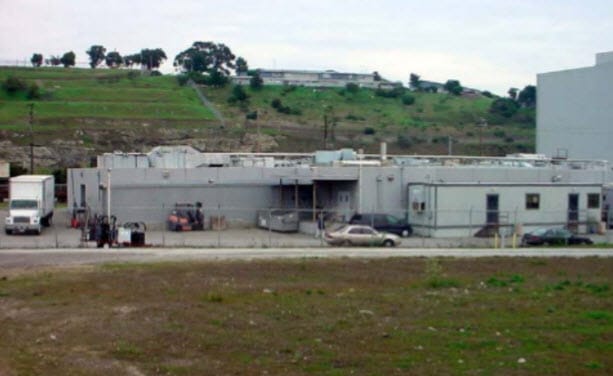
The Navy designates Building 830 to be a FUDS, a Formerly Used Defense Site. The UCSF Controller assigned Hunters Point Building 830 Building code 2417 and designates it an outlying facility.
Missing from the diagram are 23,000 people living on city streets next to a “naked” chain metal fence that courses south to the north shore of Yosemite Slough.
Here is where the Navy deposited radioactive metal slag – blocks away from senior housing, children’s playgrounds, churches, nonprofits and neighborhood health centers. These people are being surveyed and their health effects documented by the Hunters Point Community Toxic Registry.
Cleanup records highlight how dangerous exposure to the Parcel E-2 landfill and groundwater is for shipyard neighbors living and working nearby. Navy documents show breathing vapors from landfill gas carries cancer risks as high as 1 in 10,000 for shipyard workers and groundwater exposure risks as astronomically high as 5 in 1,000 for residents living on nearby city streets like Fitch, Griffith and Ingalls.
Six blocks west of the shipyard’s panhandle region courses Third Street, a major commercial and industrial corridor for the City and County of San Francisco and the principal transit corridor for Bayview Hunters Point and millions of people entering the city northbound from Highway 101.
Air monitoring data collected by the Navy this year from stations located along the heavily populated western fence line detect elevations in asbestos, arsenic, manganese, lead and total particulates at upwind monitors U1 through U6 in regions along the western fence line on Fitch Street, adjacent to the Parcel E-2 landfill.
These regions are designated Tier 1 hot spots where chemicals of concern are detected in soil at concentrations 10 times greater than remediation goals and where groundwater concentrations exceed aquatic quality goals.
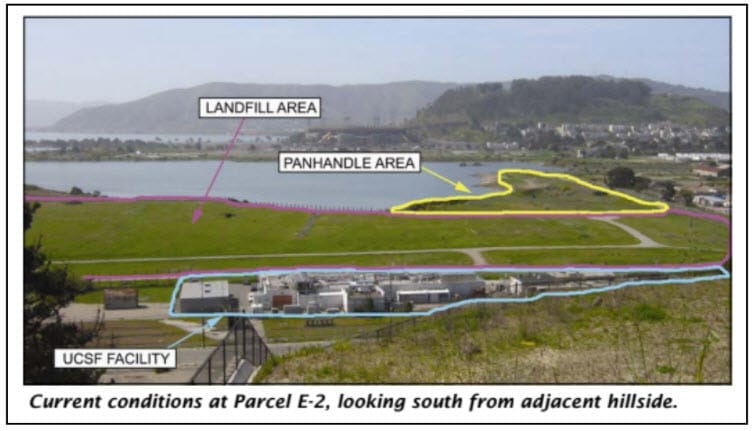
‘I can’t breathe.’ Doctor say, ‘It’s cuz you FAT!’
John Miranda is the hero of this story. Miranda is a quiet man whose intelligence is often underestimated. A tendency to minimize his trained observational skills and dismiss his medical symptoms is due to the fact he is an obese Latino male.
Miranda is the subject of a PBS NOVA Science documentary by Firelight Productions scheduled for filming in early January 2024. The topic of the documentary is medical racism – and Miranda is an expert.
In 2021, Miranda was featured in the San Francisco Public Press article “Toxic Metals Found in Shipyard Neighbors, but Source Still Unknown,” authored by award winning journalist Chris Roberts.
After 26 years as a loyal worker, Miranda grew tired and fatigued. He developed difficulty breathing and lightheadedness that interfered with his ability to work – and to walk. Miranda is a non-smoker with no evidence in his 26 year work history of allergies to animal fur or dust. He underwent a battery of pulmonary function tests in 2019.
Performed by a pulmonologist and a cardiologist, the studies revealed he had heart failure, occupational asthma and the type of damage to his lung tissue seen in people exposed to chemicals, fumes and toxic air contaminants called interstitial lung disease.
Miranda was referred to an expert in occupational medicine and reports within “five minutes of entering the office” was told his difficulty breathing was because “you are overweight.”
Scholarly research on medical racism offers evidence that obesity’s disproportionate harms to Black, Indigenous and People of Color (BIPOC) may be attributed to systemic racism in medical institutions.
“The immense costs – to lives, health and wealth – of not preventing and treating obesity are exacerbated for people of color. We urgently need to study and solve the core issues at the intersection of obesity and systemic racism,” observes Fatima Cody Stanford, MD, MPH, MPA of the Weight Center-Massachusetts General Hospital.
“First, it is important to recognize that the interplay of obesity and racism is real,” says Stanford, an obesity medicine physician-scientist, educator and policy maker at Harvard Medical School. Research identifies obesity to be a product of systemic racism that influences the tendency of medical professionals to offer negative, judgmental and substandard care to people of color who are overweight.
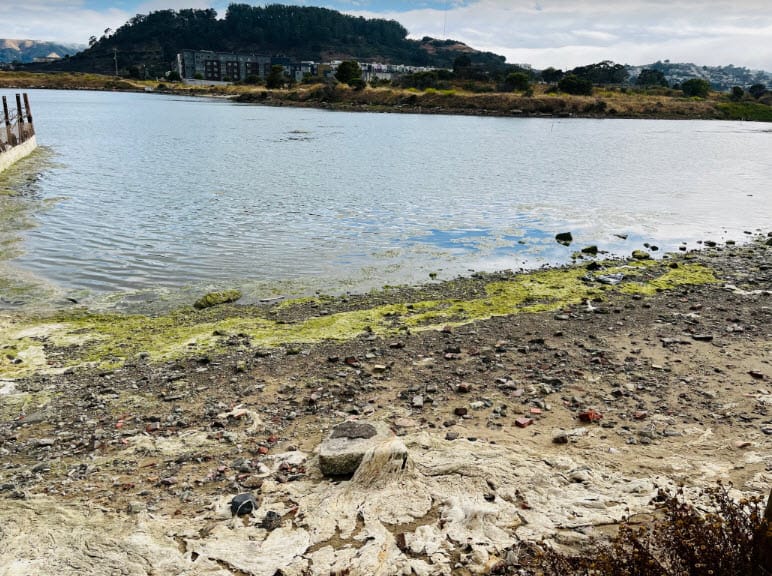
Fifteen current and former UCSF shipyard workers have undergone urinary biomonitoring screenings beginning in 2020. Repeat screenings were conducted this year. All workers have manganese detected in concentrations exceeding remediation goals. Manganese has a 100% detection frequency in shipyard soils and air monitoring. Uranium, cesium, cobalt, thallium, tungsten and arsenic have also been detected in the UCSF shipyard workers – in astounding concentrations.
HP Biomonitoring’s geospatial mappings are undergoing digital conversion through a CalEPA EJ small grant award. They include the South Basin cluster – four chemicals detected in aggregate including arsenic, gadolinium, manganese and vanadium, the Radiogenic Cancer Cluster and the Breast Cancer Necklace.
The Breast Cancer Necklace – red indicator pins placed at the location where a woman has been diagnosed with breast cancer encircles the Parcel E-2 landfill within its half mile perimeter.
All four geospatial mappings share a common feature: Chemical and cancer clusters are densely distributed within the half mile perimeter of the Hunters Point Naval Shipyard.
The clustering is heavily concentrated along the entry corridors to the shipyard’s Crisp Road main gate and radiation laboratories and track along the western fence line – adjacent to the Parcel E-2 landfill.
The ROC Cluster is a geospatial mapping of locations where biomarkers of radionuclides of concern are being detected in high concentrations in residents and workers nearby.
All four chemical and cancer cluster mappings correspond to heavily contaminated regions of the shipyard. Each colored pin corresponds to the location where radioactive and chemical biomarkers are being detected in high concentrations. In both the ROC and the Radiogenic Cancer mappings, dense clusters of pins track along the Crisp Road to Palou Avenue main gate and along the western fence line.
In Building 830, where 30 UCSF workers are being exposed to nuclear waste in landfill soils and radioactive fugitive dust emissions, both cancer and chemical clusters are being mapped.
In Building 606, where the Navy leased a facility to the San Francisco Police Department constructed on the footprint of a radioactive laundry, a cancer cluster can be constructed drawn from legal documents.
The Building 606 cancer cluster includes two cases of brain cancer plus lung, thyroid, prostate cancer and the deaths of German Shepherd service animals from sarcoma, a canine cancer induced by radiation exposure.
Settlement proposed for UCSF shipyard worker with a radioactive truck
A settlement has been proposed in a workers’ injury claim filed by University of California employees stationed in Building 830 at 75 Crisp Rd., feet away from a methane emitting, radiation contaminated industrial landfill on a Federal Superfund site. Building 830 was used by NRDL as an animal kennel and sold to UCSF in 1970 after its closure.
Buildings 830 and 831 are radiologically impacted and were never cleared by the California Department of Public Health for human occupancy as required by federal Superfund law.
An independent scoping survey conducted in 2022 for UCSF by Philotechnics detected “several radionuclides above background, including cesium, radium, thorium, uranium and their progeny.”
The EPA ECHO Enforcement tool identifies the top two environmental law violators in the 94124 zip code to be the Southeast waste water pollution control plant and the Hunters Point Naval Shipyard Facility Search – Enforcement and Compliance Data/ECHO/US EPA.
The southern shoreline of the Hunters Point Naval Shipyard contains an industrial landfill designated Parcel E-2. The Parcel E-2 landfill occupies a horseshoe shaped region of the shoreline. It drains “like a toilet” into the South Basin of San Francisco Bay and travels westward into Yosemite Slough, within four blocks of senior housing, the Southeast Health Center, Bayview K.C. Jones Playground, Martin Luther King swimming pool, McDonald’s and a host of nonprofits and businesses.
On Aug. 16, 2000, at 11:30 a.m., base security activated federal firefighters to a fire in Parcel E-2. They extinguished the fire over 48 hours. It smoldered underground for weeks fueled by volatile gases, flammable building materials, trash and debris beneath the landfill surface. Then it reignited on Aug. 24, 2000.
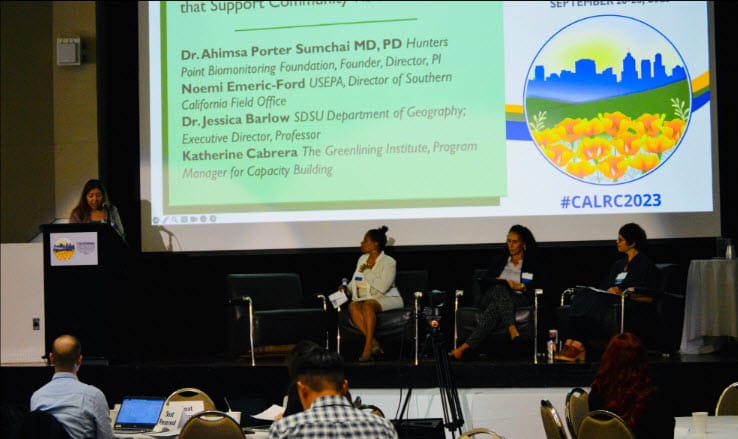
John Miranda is the lead plaintiff in an occupational injury case filed by UCSF workers with respiratory disease and cancer. Miranda is disabled by heart failure and chronic lung disease.
In legal statements, the workers report they witnessed the Parcel E-2 landfill fire erupt in “green, yellow and orange” flames on Aug. 16, 2000, in front of Building 830. They were never safely evacuated or relieved of duty.
The landfill fire was ignited by methane gas pockets beneath its surface on a summer day in Bayview when temperatures exceeded 93 degrees.
It took a year for the Agency for Toxic Substances & Disease Registry to complete its investigation of the Parcel E-2 landfill fire. Although air monitoring samples were not collected until three weeks after the surface fires had been extinguished, the ATSDR report documents manganese was detected in high concentrations.
UCSF workers and nearby residents described the colorful flames of the landfill fire that erupted on Aug. 16, reignited on Aug. 24, and smoldered underground for months, fueled by subsurface methane, carbon dioxide, volatile organic compounds and heavy metals like strontium, calcium, copper and potassium.
These heavy metals are carried to the surface by landfill gases in what is called an “entourage effect.” These landfill heavy metals are being detected in shipyard “neighbors” using a urinary toxic exposure screen that detects 35 chemicals.
A cross-sectional diagram was distributed by the Navy to the Shipyard Restoration Advisory Board (RAB) in 2001 that details the proximity of methane gas and landfill debris to the UCSF compound.
Methane gas in concentrations exceeding 60% volume in air emanated into the UCSF compound. In medicolegal documents, UCSF workers reported the smell of methane gas and Parcel E-2 soils on their vehicles.
In legal records, UCSF workers report witnessing Navy personnel release the contents of the Parcel E-2 landfill into the atmosphere above the City of San Francisco, within feet of the western fence line neighborhood. A worker who witnessed the landfill release underwent surgery this year for colon cancer at the age of 55.
Navy Operations obtains approval to release gases beneath the surface of the landfill – including methane in suffocating, explosive, global warming concentrations exceeding 60% volume in air as confirmed in an email by Nina Bacey, former Department of Toxic Substances Control representative on the Base Realignment and Closure Team.
John Miranda’s 2020 urinary screening detected manganese in elevated concentrations. The finding was verified by Quest Laboratory. A repeat biomonitoring screening conducted in 2023 detected four chemicals known to be present in shipyard soil; ne is cobalt. Cobalt 60 is a radionuclide of concern at the Parcel E-2 landfill.
As a condition of settlement, manganese detected in high concentrations in Miranda’s urine will be accepted as evidence of occupational injury. This is a legal victory for the Hunters Point Community Biomonitoring Program, where manganese has been detected in high concentrations in an estimated 80% of screenings conducted to date. As further condition of the settlement, Miranda cannot return to work at Building 830. It is deemed an unsafe work environment.
John Joseph Miranda never set out to become a Superhero every morning at 5 a.m. when he arose for work. But geiger counter readings conducted on the truck he drove faithfully to Building 830 for 26 years detected high radioactive gamma wave and particle emissions. Miranda, and 15 dangerously exposed fence line residents are about to take on the United States Navy at the Hunters Point Naval Shipyard!
In a grand cacophony of legal actions, the Greenaction/UC Berkeley Hunters Point filing, the San Francisco Police Department wrongful death lawsuit, the Hunters Point Community Lawsuit and the Federal Tort Claims filed by 15 fence line residents and workers will all move forward in February of 2024.
SF Bay View Health and Environmental Science Editor Ahimsa Porter Sumchai, MD, PD, founder and principal investigator for the Hunters Point Community Biomonitoring Program, founding chair of the Hunters Point Naval Shipyard Restoration Advisory Board’s Radiological Subcommittee and contributor to the 2005 Draft Historical Radiological Assessment, can be reached at AhimsaPorterSumchaiMD@Comcast.net. Dr. Sumchai is medical director of Golden State MD Health & Wellness, a UCSF and Stanford trained author and researcher, and a member of the UCSF Medical Alumni Association Board of Directors.

 Store
Store


